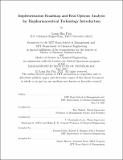| dc.contributor.advisor | Welsch, Roy | |
| dc.contributor.advisor | Love, J. Christopher | |
| dc.contributor.author | Pan, Long Bin | |
| dc.date.accessioned | 2022-01-14T15:12:28Z | |
| dc.date.available | 2022-01-14T15:12:28Z | |
| dc.date.issued | 2021-06 | |
| dc.date.submitted | 2021-06-10T19:13:21.900Z | |
| dc.identifier.uri | https://hdl.handle.net/1721.1/139455 | |
| dc.description.abstract | Biologics manufacturing is complex involving several unit operations for drug production. As the industry moves forward, new technologies are introduced to decrease cycle time, reduce costs, and improve quality for these processes. Amgen aims to innovate, improve, and transform through a culture of continuous improvement, delivering platforms and year over year productivity. The organization strives to improve its reliability, efficiency, agility and differentiation of its drug manufacturing capabilities through introduction of next generation technologies. However, technology implementation at Amgen is overwhelmingly complicated due to the diversity of products at different life cycle stages, differences in manufacturing sites, differences in developing departments, differences in technology usage and stringent regulatory requirements for process changes in GMP facilities. These internal and external factors inadvertently lead to inconsistent technology implementation plans and inefficient execution strategies.
The objective of this research is to identify the best practices for biopharmaceutical project management in order to improve the current technology implementation roadmap at Amgen by targeting specific areas of opportunities. The roadmap aims to reduce waste caused by delays and reworks, improve efficiency, and drive towards right-first-time implementation. The second objective of the internship project involves the evaluation of real options analysis as an alternative financial analysis approach to the discounted cash flow method currently used at Amgen. This approach adapts well to technology development as decision makers are able to learn new information after each project phase and can act upon the new data. Overall, the two tools work in conjunction to assist in investment decisions for new technologies and streamline technology implementation plans. | |
| dc.publisher | Massachusetts Institute of Technology | |
| dc.rights | In Copyright - Educational Use Permitted | |
| dc.rights | Copyright retained by author(s) | |
| dc.rights.uri | https://rightsstatements.org/page/InC-EDU/1.0/ | |
| dc.title | Implementation Roadmap and Real Options Analysis for Biopharmaceutical Technology Introduction | |
| dc.type | Thesis | |
| dc.description.degree | S.M. | |
| dc.description.degree | M.B.A. | |
| dc.contributor.department | Massachusetts Institute of Technology. Department of Chemical Engineering | |
| dc.contributor.department | Sloan School of Management | |
| mit.thesis.degree | Master | |
| thesis.degree.name | Master of Science in Chemical Engineering | |
| thesis.degree.name | Master of Business Administration | |
